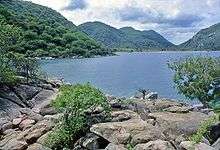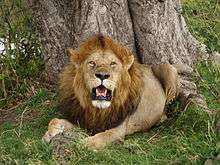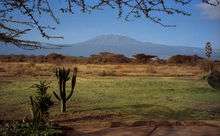Southeast Africa
Southeast Africa[1][2] or Southeastern Africa[3][lower-alpha 1] is an African region that is intermediate between East Africa[lower-alpha 2] and Southern Africa.[lower-alpha 3][8] It comprises the countries Botswana, Burundi, Eswatini, Kenya, Lesotho, Malawi,[9] Mozambique,[10][11] Tanzania, Uganda,[12] Zambia and Zimbabwe[13] in the mainland, with the island-nation of Madagascar also included.[10]

History
Prehistory
East and southern Africa are among the earliest regions where modern humans (Homo sapiens) and their predecessors are believed to have lived. In September 2019, scientists reported the computerized determination, based on 260 CT scans, of a virtual skull shape of the last common human ancestor to modern humans/H. sapiens, representative of the earliest modern humans, and suggested that modern humans arose between 350,000 and 260,000 years ago through a merging of populations in South and East Africa.[14][15]
Bantu expansion
Bantu-speakers traversed from Central Africa into Southeast Africa approximately 3,000 years ago.[10]
Swahili coast
Urewe
Madagascar
Kitara and Bunyoro
Lake Plateau states and empires
Buganda
Rwanda
Burundi
Maravi
Modern history
In the 19th and 20th centuries, David Livingstone[16] and Frederick Courtney Selous visited Southeast Africa. The latter wrote down his experiences in the book Travel and Adventure in South-East Africa.[17]
Demographics and languages
People include the San people.[3] The Swahili language is spoken, both as an official language and lingua franca, by millions of people.[18]
Culture
Art
Architecture
Clothing
Cuisine
Music
Religion
Film industry
Science and technology
Health
Climate
Natural Disasters
Wildlife

Fauna[17] includes the cheetah, leopard, lion,[21] Nile crocodile, hyena, Lichtenstein's hartebeest and white rhinoceros.
Notes
References
- Axworthy, Mary (2004). Sowell, Teri L. (ed.). Asking for Eyes: The Visual Voice of Southeast Africa. University Art Gallery, San Diego State University. ISBN 0937097012.
- Wieschhoff, H. A. (2013). The Zimbabwe-Monomotapa Culture in Southeast Africa. Literary Licensing L. L. C. ISBN 978-1494009939.
- Schlebusch, C. M.; Prins, F.; Lombard, M.; Jakobsson, M.; Soodyall, H. (2016). "The disappearing San of southeastern Africa and their genetic affinities". Human Genetics. 135 (12): 1365–1373. doi:10.1007/s00439-016-1729-8. PMC 5065584. PMID 27651137.
- "Southeastern Africa: South Africa, Mozambique, Botswana, Zambia, Zimbabwe, Swaziland, Namibia, and Malawi", World Wildlife Fund, retrieved 2018-04-30
- Turok, Ben (1990). Witness from the frontline: aggression and resistance in Southern Africa. Institute for African Alternatives. p. 86. ISBN 187042512X.
- Jama, Abdillahi H. (2002). "11". Values in Islamic culture and the experience of history. pp. 303–322. ISBN 1135434166.
- Bechaus-Gerst, Marianne; Blench, Roger (2014). "11". In Kevin MacDonald (ed.). The Origins and Development of African Livestock: Archaeology, Genetics, Linguistics and Ethnography - "Linguistic evidence for the prehistory of livestock in Sudan" (2000). Routledge. p. 453. Retrieved 15 September 2014.
- Klopper, S., Conru, K., and Nel, K. (2002). The Art of Southeast Africa: From the Conru Collection. Harry N. Abrams. ISBN 8874390017.CS1 maint: uses authors parameter (link)
- "Malawi", Merriam-Webster, retrieved 2018-04-29
- "Bantu Ethnicity in South East Africa: From Kenya to the Southern Tip of Africa". Ancestry.com. Retrieved 2018-04-29.
- "Mozambique", Merriam-Webster, retrieved 2018-04-29
- "Tracing African Roots: Exploring the Ethnic Origins of the Afro-Diaspora". Tracing African Roots. Retrieved 2018-04-29.
- Fry, Kathie. "Southeast African Countries". Do It In Africa. Retrieved 2018-04-19.
- Zimmer, Carl (10 September 2019). "Scientists Find the Skull of Humanity's Ancestor — on a Computer - By comparing fossils and CT scans, researchers say they have reconstructed the skull of the last common forebear of modern humans". The New York Times. Retrieved 10 September 2019.
- Mounier, Aurélien; Lahr, Marta (2019). "Deciphering African late middle Pleistocene hominin diversity and the origin of our species". Nature Communications. 10 (1): 3406. doi:10.1038/s41467-019-11213-w. PMC 6736881. PMID 31506422.
- Douglas, John (Summer 1998). "Malawi: The Lake of Stars". Travel Africa (4). Archived from the original on 2009-01-14. Retrieved 22 August 2008.
- Selous, F. C. (2011). "XXV". Travel and Adventure in South-East Africa. New York: Cambridge University Press. p. 445. ISBN 978-1108031165.
- Irele 2010
- "Freshwater Fish Species in Lake Malawi (Nyasa) [Southeast Africa]". Fishbase.org. Mongabay. 2001-11-15. Retrieved 2016-12-09.
- "Limpopo River", Encyclopædia Britannica, retrieved 2018-04-29
- Jackson, D. (2010). "Introduction". Lion. London: Reaktion Books. pp. 1–21. ISBN 978-1861897350.

.svg.png)